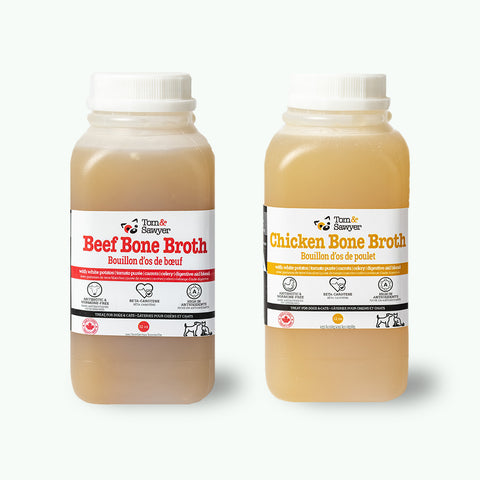Are you noticing that your once-spry dog is now walking a little stiffer, and moving a little slower? It may be an indication of osteoarthritis, and can be a painful and unpleasant diagnosis.
In this article, we explore the topic of arthritis in dogs, including its signs, causes, treatment, and how Tom&Sawyer’s wholesome, gently-cooked meals can play a pivotal role in prevention.

Understanding Arthritis in Dogs
Osteoarthritis is a degenerative joint disease that is a common ailment among our canine friends, especially seniors and large breeds. Unlike some conditions that can be cured outright, arthritis is chronic and requires ongoing management.
Let’s break it down:
- What Is Osteoarthritis?
-
Osteoarthritis occurs due to the gradual deterioration of joint cartilage. In a healthy joint, cartilage acts as a cushion, allowing smooth movement. However, factors like age, injury, repetitive stress, excess body fat mass, or disease can all lead to cartilage breakdown.
The result? Pain, inflammation, limited range of motion, and the formation of bone spurs.
While any joint can be affected, osteoarthritis most commonly impacts limbs and the lower spine.
- Detecting early signs of osteoarthritis can be challenging, as some dogs are stoic and hide their pain. However, some symptoms to look for with arthritis includes:
- Stiffness, limping, or difficulty getting up
- Lethargy
- Reluctance to run, jump, or play
- Weight gain
- Irritability or behaviour changes
- Pain when touched
- Muscle loss over limbs and spine
- Certain factors increase the likelihood of osteoarthritis:
- Large or giant breeds, specifically, improper growth and development as puppies
- Overweight or obese dogs are at greater risk
- Repetitive stress from athletic activities
- Prior injuries (i.e. fractures, ligament tears)
- Hip or elbow dysplasia
- Infections affecting joints (i.e., Lyme Disease)
- Genetics and poor conformation
Managing Arthritis: Treatment and Prevention
- Treatment Focus
- While there’s no cure for osteoarthritis, early detection and appropriate management can improve your dog’s quality of life.
Treatment aims to:
- Control pain
- Decrease inflammation
- Enhance overall well-being
- Slow disease progression
- If you believe that your dog is exhibiting signs of osteoarthritis seek veterinary care.
- Diet can play a role within a treatment or management plan. Some nutrients to look for include:
- Omega-3 Fatty Acids: High-quality fish oils provide these essential nutrients. They support joint health and reduce inflammation. They have high evidence through clinical trials for their efficacy in reducing symptoms of osteoarthritis in dogs.
- Glucosamine and Chondroitin: These naturally occurring compounds promote joint cartilage function. While there is less clinical evidence for their efficacy, some reports suggest improvements in symptoms.
- Antioxidants: Diets rich in antioxidants can be beneficial in reducing oxidative stress that can occur with osteoarthritis though there is a dearth of research available for their clinical efficacy.
-
Collagen: A few, smaller scale studies, have shown some benefits of collagen-based ingredients and symptoms of osteoarthritis. Collagen is an integral component to cartilage and the strength and flexibility of the connective tissue at the joint. Bone broths can provide a source of collagen and collagen can be naturally present in animal derived ingredients.

Preventing Osteoarthritis: A Holistic Approach
- Dietary Choices
- Tom&Sawyer’s fresh pet food is ideal for prevention:
- Customized: We have meal plans that can be developed based on your dog’s individual needs, ensuring optimal nutrition and portion sizes.
- Omega 3 Fatty Acids: All of our meals contain a rich source of omega-3’s and are within the appropriate omega-6 to omega-3 ratios that are considered to be beneficial for anti-inflammation.
- Rich in Antioxidants: Reducing oxidative stress can play a role in keeping your pup and their joints healthy as they age!
-
Supports Healthy Aging: Although age itself is not a direct cause for osteoarthritis, aging can increase the risk for arthritis. A nutritious diet to support healthy aging and senior pups can help!

- Exercise and Weight Management
- Regular, low-impact exercise keeps joints moving.
- Maintain a healthy weight to reduce strain on joints.
- Diet can play an important role in weight management. We have a line of low-fat recipes that may be an option for pups carrying a bit of extra weight. For a guide to safe weight loss in dogs, you can read our previous blog post here.
- Bone broths contain collagen, an integral component to cartilage and the strength and flexibility of the connective tissue at the joint. Adding bone broth to your dog’s food as a topper on their daily meals is an easy and natural way to introduce additional collagen into their diets.
Remember, a proactive approach is key. Regular wellness visits to your veterinarian help catch signs early and ensure your dog’s overall health. Together, we can keep our furry companions active, happy, and thriving! 🐾
Written by: Hannah Godfrey
Animal Nutritionist
BSc.H. | MSc. Animal Nutrition
www.tomandsawyer.com
References:
- Barbeau- Grégoire M, et al.2022 systematic review and meta-analysis of enriched therapeutic diets and nutraceuticals in canine and feline osteoarthritis. International Journal of Molecular Science. 2022.
- Bauer JE. Responses of dogs to dietary omega-3 fatty acids. Timely Topics in Nutrition. 2007.
- Bland SD. Canine osteoarthritis and treatments: a review. Veterinary Science Development. 2015.
- Budsberg SC, Bartges JW. Nutrition and osteoarthritis in dogs: does it help? Veterinary Clinics of North America: Small Animal Practice. 2006.
- Deparle LA, et al. Efficacy and safety of glycosylated undernatured type-II collagen (UC-11) in therapy or arthritic dogs. Journal of Veterinary Pharmacology and Therapeutics. 2005.
- Kaur H. Role of omega-3 fatty acids in canine health: a review. International Journal of Current Microbiology and Applied Sciences. 2020.
- Case LP et al. Canine and Feline Nutrition: A Resource for Companion Animal Professionals 3rd Ed. 2010.
- National Research Council. (2006). Nutrient requirements of dogs and cats.
- Hand MS, et al (ed.) Small animal clinical nutrition, 4th ed. Topeka, KS: Mark Morris Institute. 2000.
Do you give your dog a bite of your food every now and then? It’s likely something that most dog owners do — after all, it can be so hard to resist those sweet doggie eyes!
Whether you have a hard time saying no when your dog asks for a taste of your food, or if your dog has a habit of getting into things they shouldn’t, it’s important that dog owners are aware of the common foods that are poisonous for dogs.
Here’s a list of five ingredients that most people have in their home that can cause severe illness — and in some cases, death — in dogs.
Note: If you know, or even suspect, that your dog has ingested any of these items, call your veterinarian or take your dog to the nearest emergency clinic.
1. Chocolate
There are two major components in chocolate that make it toxic to dogs, both of which are classified as methylxanthines. The first is theobromine and the second is caffeine; small doses of either component can cause vomiting, diarrhea, excessive panting, and hyperactivity in dogs. Chocolate toxicosis can occur when dogs consume large amounts, with the lethal dose being approximately one ounce of chocolate per pound of body weight. Chocolate toxicosis results in tremors, abnormal heart murmurs, seizures, and ultimately death.
2. Onions and Garlic
Onions, and other vegetables in the Allium spp. genus (i.e. garlic, leeks and chives), contain high levels of sulfur-containing oxidants. These have been associated with hemolysis, a condition affecting the red blood cells. The onset of hemolysis is often slow, but can lead to anorexia, increased heart rate, weakness, and ultimately death.
3. Grapes
Consumption of grapes (and raisins) is associated with kidney failure in dogs; however, it is unclear what component in grapes causes this. Death has been documented in dogs after consuming a minimum of 3-5 grapes. Dogs may experience abdominal pain, weakness, drowsiness, dehydration and tremors.
4. Macadamia Nuts
As with grapes, is not known how macadamia nuts are toxic to dogs; however, within 12 hours of consuming macadamia nuts, a dog may show clinical signs of toxicity such as anorexia, vomiting, nausea, muscle weakness, and tremors. Death is not usually an outcome of macadamia nut ingestion, and most signs disappear after 24 or 48 hours.
5. Citrus Fruits
The high levels of citric acid in citrus fruits can cause stomach upset and digestive issues in dogs when consumed in large quantities. At extreme levels, damage to the central nervous system can occur.
Things to Remember
Keep all food items out of reach for your dog, whether it’s harmful or not. If your pup eats extra food or food they aren’t used to — even if it’s safe — they can still experience digestive upset.
If your dog has consumed a food item that is not on this list, or if you are unsure about whether an ingredient is harmful for dog, you can use the ASPCA website to verify. You can also call the Pet Poison Helpline at 855-764-7611.
“People Food” Dogs Can Eat
There is some good news! If you’re looking to feed your dog “people food”, check out Tom&Sawyer’s meals for dogs. Our meals are gently cooked and made with human-edible cuts of meat, fresh fruits and veggies and created by chefs, balanced by nutritionists and thoroughly tested for safety. In fact, our fresh cooked meals are so good, you could eat them too!
Phone numbers to keep on hand in case of an emergency:
- The Pet Poison Helpline: 855-764-7661 | www.petpoisonhelpline.com
- ASPCA: 888-426-4435 | www.aspca.org
- Your local veterinarian
- Your local emergency veterinarian for emergencies that occur after-hours
Written by: Hannah Godfrey
Animal Nutritionist
BSc.H. | MSc. Animal Nutrition
www.tomandsawyer.com
Reference:
Merck Veterinary Manual
